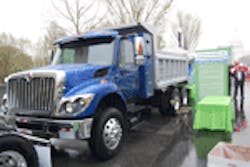A new business alliance forged between truck maker Navistar and natural gas fuel provider Clean Energy aims to jumpstart a widespread conversion in the U.S. among fleets of all types from using gasoline and diesel fuels to natural gas – with or without the help of government incentives.
“For the longest time, for natural gas to work in the trucking business, it needed government support,” noted Daniel Ustian, Navistar’s chairman, president & CEO in a conference call with reporters from the company’s headquarters in Lisle, IL, outside of Chicago.
“While we will always take what we can get [in terms of government support], this alliance will stand on its own,” he explained. “It will afford us the ability to set up a national natural gas refueling infrastructure; afford us the ability to develop the most integrated [natural gas] powered products; and afford significant cost savings to customers.”
Ustian – joined by T. Boone Pickens, chief investment officer for BP Capital Management, Andrew Littlefair, president and CEO of Clean Energy, Jim Hebe, Navistar’s senior vp-North American sales operations, and Jerry Moyes, president of Swift Transportation – revealed that this new business alliance will require fleet customers to buy natural gas fuel under contract from Clean Energy for a set period of years as well as lease natural gas-powered trucks from Navistar.
In return, fleets avoid paying the often significant five-figure premium charged for natural gas-powered trucks versus their diesel-powered brethren – charges that can range from $27,750 to over $72,000 per unit, depending on the vehicle’s class, according to recent study by global consulting firm Frost & Sullivan.
Even after accounting for the cost of the contracted fuel price and truck leases under the program, Navistar’s Hebe contends that fleets should still recoup savings from the lower cost of natural gas versus diesel on the order of 50 to 70 cents per gallon.
“We came to realize we needed to mitigate four major barriers to the wider adoption of natural gas as a transportation fuel: the lack of a national refueling infrastructure, adequate availability of natural gas-powered technology, sustainable cost differences between natural gas and diesel, and the affordability of natural gas-powered trucks,” Hebe said. “This alliance addresses all of those issues.”
Clean Energy’s Littlefair said his company initially plans to build 70 liquefied natural gas (LNG) refueling stations along major highway corridors in the U.S. this year and another 100 facilities in 2013; roughly a $200 million investment. He added that Clean Energy plans to add 100 to 150 locations annually to provide both LNG and compress natural gas (CNG) over the next five years should demand increase.
Hebe noted that Navistar’s medium-duty DuraStar and WorkStar chassis will be available with a natural gas fired MaxxForce DT engine by the end of the first quarter this year, with its TranStar model available with a Cummins ISL G natural gas engine ready for deployment by mid-2012.
By the start of 2013, Navistar plans to roll out a ProStar tractor equipped with a MaxxForce 13L diesel pilot injected (DPI) natural gas engine, followed by a PayStar natural gas model.
Hebe said Navistar’s 13L engine-equipped tractors should offer equivalent horsepower and torque ratings to diesel-powered models and be capable of traveling between 400 and 650 mi. with either 80 or 100 equivalent-gallons worth of LNG on board; configurations that should add only 100 extra lbs. of weight to the vehicle, he explained.
Clean Energy’s Littlefair is confident of the rapid adoption of natural gas by fleets via this program based in part on the refuse industry’s experience over the last four years. “In 2008, when Cummins first introduced its ISL G engine, 3% of new trash trucks were ordered with it. By 2012, some 42% of new orders are expected to be natural gas powered trucks,” he said, adding that two of the largest refuse companies in the U.S. – Waste Management and Republic Services – plan to make 80% and 65% of their new orders, respectively, natural-gas powered trucks this year.
“We’re fools in this country if we don’t do this,” stressed Pickens, a vocal and long-time advocate of natural gas use by the transportation industry and who is also co-founder, director, and 30% shareholder of Clean Energy.
“The reason for our focus on trucks is that they are the biggest users of diesel fuel in this country – and could see the biggest savings,” he said.
Swift’s Moyes noted that his companies – Swift and Central Freight Lines – consume about one million gallons of diesel fuel per day, and with natural gas offering at the moment a $1.50/gal. price advantage, the savings from a switch “would be big.”
“We like what we see,” he said, noting that Swift is testing about 16 natural gas-powered trucks at the moment – six powered by a Cummins ISX model running on a mix of diesel and CNG as well as 10 equipped with Cummins ISL G engines.
“I think within three or four years, 30% to 40% of our fleet could be natural gas powered, if we have the product and refueling infrastructure available,” Moyes added. “That’s why we’re going after this full bore as soon as we can.”
About the Author
Sean Kilcarr
Editor in Chief
Sean Kilcarr is a former longtime FleetOwner senior editor who wrote for the publication from 2000 to 2018. He served as editor-in-chief from 2017 to 2018.
